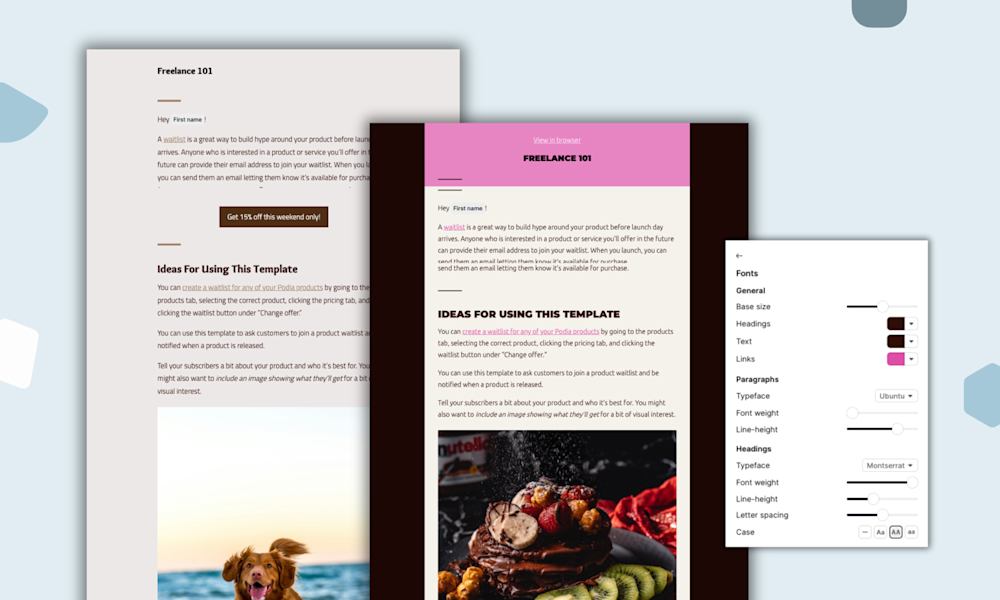Your blog is thriving.
You’re creating great content on a regular publishing schedule, and your SEO-optimized blog posts keep bringing in new readers.
But to sell digital products, you need customers, not just readers. And there are so many marketing “growth hacks” out there, it’s hard to know what to believe. As a busy entrepreneur, you don’t have time to try every marketing strategy out there to see what works.
You know that blogging is good for your bottom line. After all, businesses with a blog generate about 67% more leads than those without one. You just need a way to bring in those leads.
That’s where email marketing comes in. It’s one of the most popular digital marketing tools for a reason: Email marketing has one of the highest ROIs of any marketing tool, and getting started is simple.
So simple that we broke it down into five straightforward steps.
In this step-by-step guide, you’ll learn how to turn your blog readers into email subscribers, then nurture those leads with email marketing campaigns.
Let’s start with the first step of any new endeavor: Setting goals.
Step #1: Set your email marketing goals
Email marketing can be a powerful tool. It has an ROI of around $40 for every $1 spent and drives 174% more conversions than social media.
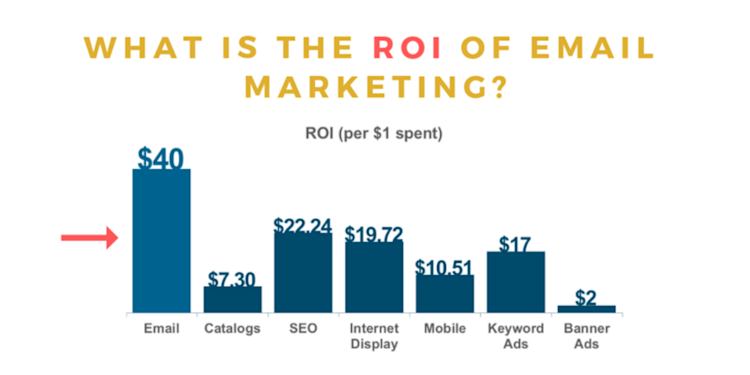
But to make the most of any tool, you need a clear idea of what you’re trying to build. That’s why it’s so important to set goals for your email marketing strategy before you start list building.
Marketers can have a bad habit of setting vague goals. We say things like “build your email list” and “qualify your leads” without actually digging into what meeting those goals looks like.
Here’s one reason why: It’s tricky to recommend universal marketing goals or ways to measure success. Every business has different key performance indicators (KPIs) depending on their goals.
Setting goals that are specific to your business helps you figure out which email metrics to track.
For example, if your goal is to collect pre-launch signups for an upcoming course, you might track the number of blog readers who sign up for your pre-launch email updates.
On the other hand, if your goal is to turn more email subscribers into online course students, you would track how many people open and click on the relevant links in your email, and how many of those subscribers then sign up for your course.
To set the right goals for your marketing efforts, we recommend the SMART goal framework.
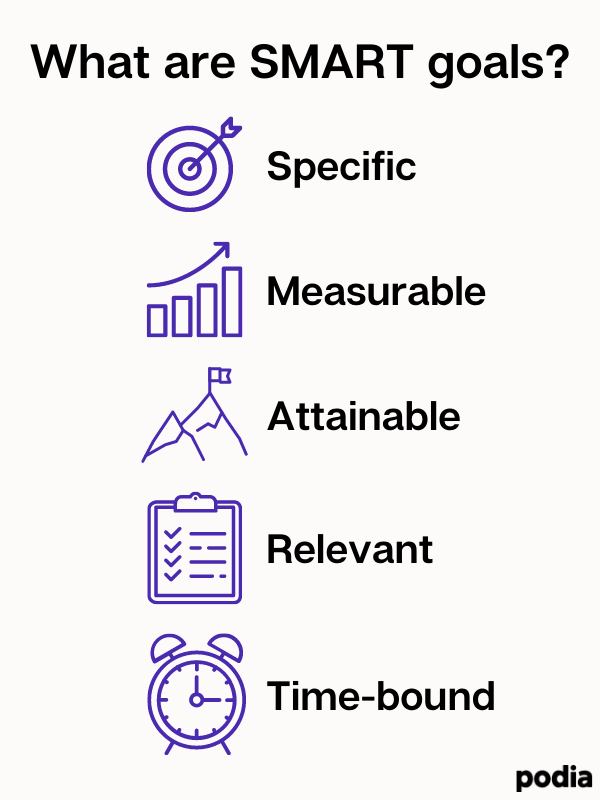
According to the SMART goal framework, goals should meet five criteria:
-
Specific: Set detailed goals that narrow in on a particular part of your business.
-
Measurable: Make sure that you can quantify your goal and track your progress.
-
Attainable: It’s fun to dream big, but pie-in-the-sky goals can quickly become discouraging. Keep your goal challenging but achievable.
-
Relevant: Check that your goal aligns with your values, brand, and overall business goals.
-
Time-bound: Give yourself a realistic deadline to achieve your goal. Deadlines hold us accountable and give us a timeline to work towards.
For example, say you want to grow your email list. Your SMART goal might be: “By adding an opt-in form to my blog, I will add 100 new subscribers to my email list in the next 60 days.”
With specific metrics in mind, a realistic goal, and an action plan to get there, you can set yourself up for success.
Speaking of that action plan, let’s move on to the next step: Using an opt-in form or lead magnet to bring in those subscribers.
Step #2: Add an opt-in form or lead magnet to your blog
To build your email list, subscribers need to opt-in to hear from you.
Make it easy for readers to join your email list by adding an opt-in form or popup to your blog. An opt-in form asks visitors for their email address, usually in exchange for something of value (like a discount or free content).
Python developer and course instructor Reuven Lerner uses the opt-in form on his blog to grow his email list.

“I’ve found that posting to my blog, and then getting blog posts repeated and re-posted by others, and then having an opt-in widget on my blog, is a great way to go,” Reuven told us.
Here are two tips to make the most of your email signup form:
-
Use a strong call-to-action (CTA). Give people a specific reason that they should subscribe to your email list — like “Teach me more Python!” from Reuven’s example.
-
Set clear expectations. Tell subscribers what information you’ll send them and how often they’ll hear from you. Reuven promises his audience new email newsletter content every Monday.
Podia’s drag-and-drop site editor makes it easy to add an email capture form to any page on your site. You can even embed it on a non-Podia website, like a WordPress blog — no plug-in required.
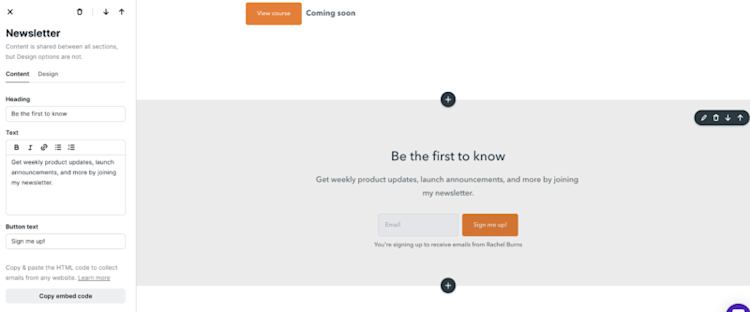
Another way to convert your readers to subscribers is via lead magnets. A lead magnet is a resource — usually a free digital download — that users receive in exchange for their contact information.
They give you their email address, you give them valuable content. It’s an excellent trade.
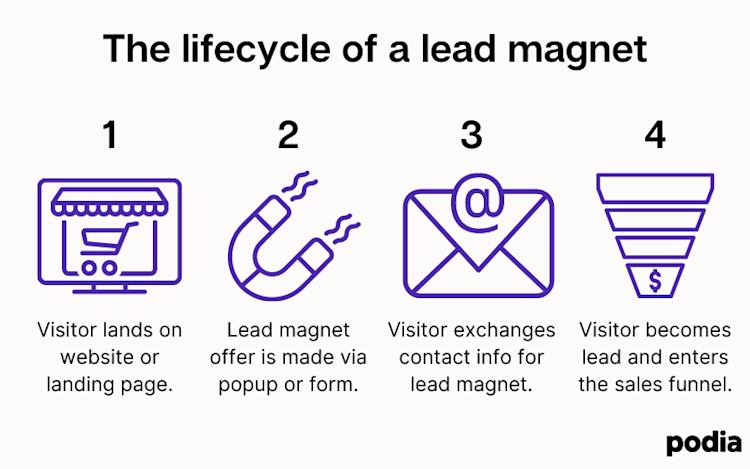
Lead magnets let you share your expertise while building your email list. A good email lead magnet does three things:
-
Addresses your target audience’s specific pain points.
-
Proves your credibility as an expert in your niche.
-
Makes people want to learn more about you and your business.
For example, business and mindset coach Becky Mollenkamp has an opt-in popup on her blog offering access to a free workshop webinar.
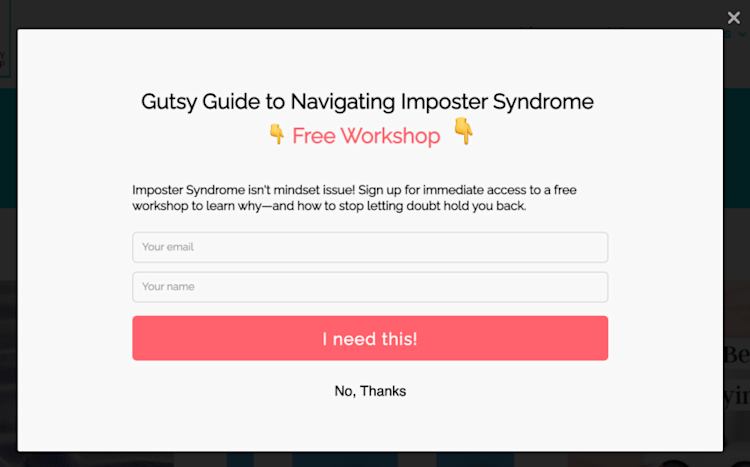
If you have a blog post that brings in a lot of traffic, you can also create a content upgrade designed specifically for that post.
To create a content upgrade:
-
Identify the content on your site that brings in the most traffic.
-
Create a lead magnet on that same topic.
-
Add that content to the relevant blog post.
-
Turn more readers into email subscribers.
Once you start collecting email addresses on your blog, you’re almost ready to start sending out emails to your new subscribers. But first, you need an email marketing platform. That’s our next step.
Step #3: Choose the right email marketing platform
There are tons of email marketing platforms for creators and bloggers to choose from, ranging from simple tools to email marketing software with every marketing automation feature you can imagine.
So, which email marketing tool should you choose?
I know I’m biased, but my vote goes to Podia.
Here’s why: Podia’s all-in-one platform was built with creators in mind.
It’s the best email marketing service for creators who want to:
-
Manage your email marketing, landing pages, and digital products all from one platform. You don’t have to worry about getting different tools to talk to each other.
-
Lessen the technical hassle to run your business.
-
Keep all of your contacts and customers in one place — no CRM software necessary.
-
Send unlimited emails without worrying about upcharges.
-
Get access to creator-first customer support.
With Podia’s email marketing features, you can send automated email campaigns, like a lead nurture sequence or welcome email series. Want to start a newsletter to share new blog posts with subscribers? Broadcast emails let you do exactly that.

Plus, you get complete revenue metrics for every email you send, which makes tracking those goals from step one a whole lot easier.
See it all for yourself with a 30-day free trial.
If you need more advanced segmentation and marketing automation features, Podia might not be the right choice for your email marketing. For more options, check out some of our other email marketing platform recommendations, including Sendinblue, AWeber, and Mailerlite.
Whichever platform you choose, it’s time to put it into action and send out your first email campaign in our next step.
Step #4: Create your first email campaign
You might be tempted to start selling to new subscribers as soon as they sign up. But if you bombard them with sales messaging right away, they’ll unsubscribe just as quickly.
Instead, make new subscribers feel right at home by sending them a welcome email.
74% of consumers expect a welcome email as soon as they subscribe. And given that new leads are most engaged within 48 hours of subscribing, the sooner you reach out, the better.
Your welcome email is your opportunity to make a stellar first impression.
Coach and entrepreneur Rachael Taylor does an excellent job welcoming subscribers to her email list with her short-but-sweet welcome email.
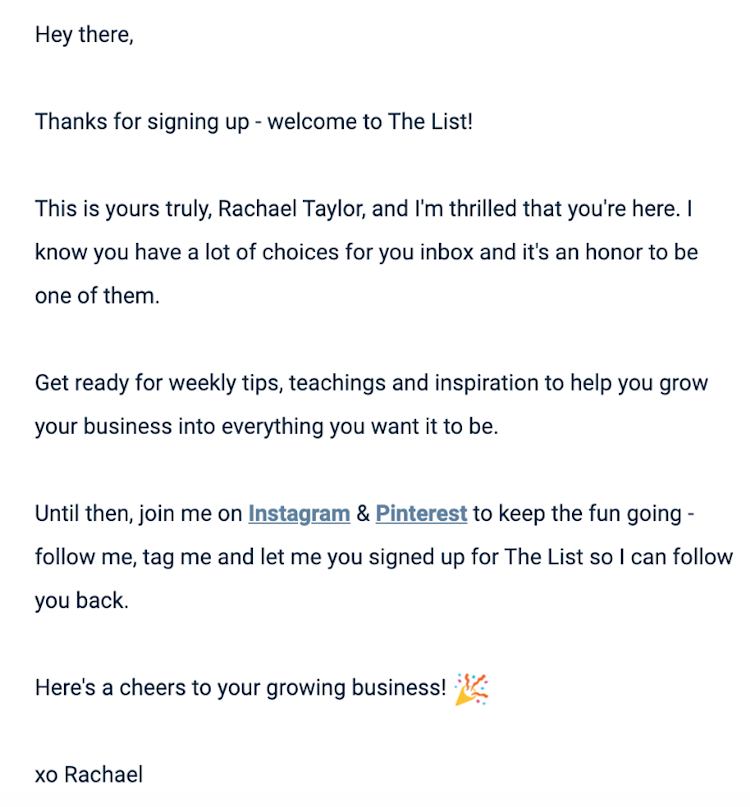
Rachael’s welcome email:
-
Thanks readers for subscribing and lets them know how much it means to her.
-
Acknowledges that having a place in her customers’ inboxes is something special (and explains why it’ll be worthwhile for them).
-
Tells them what kind of valuable content she plans to share.
For more tips on creating a top-notch welcome email — including how to set one up with Podia’s email automation — take a look at our guide to welcome emails.
After you welcome subscribers to your email list, it’s time to nurture your leads and move them through your marketing funnel.
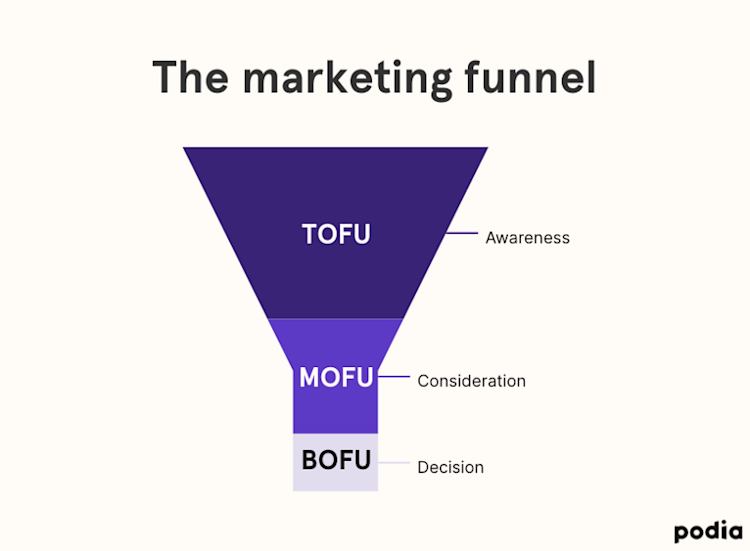
If that sounds like a lot of marketing buzzwords, don’t worry. Your marketing funnel is simply the journey that a potential customer (or “lead”) takes from their first interaction with your business until they make a purchase.
Nurturing your leads means sharing content and building a relationship with your audience, with the goal that they eventually become paying customers.
Lead nurture is one of the most important parts of marketing. In a world where 80% of new leads never translate into sales, nurturing your leads can make a big difference for your bottom line. Nurtured leads make 47% larger purchases than non-nurtured leads.

So, now that your leads have subscribed to your email list, you’re ready to nurture them with an email sequence.
-
Email 1: Introduce yourself and get your subscribers to start thinking about the problem your course can solve for them.
-
Email 2: Now that your lead is thinking about the problem, share some valuable insights with them to help them take the first steps toward solving it.
-
Email 3: Introduce your course and why it could be a great solution for them.
-
Email 4: Your lead might have a few reservations after that initial pitch. Answer the key questions they might have about your course content, pricing, and timeline.
-
Email 5: Make one final pitch. Show them why they should act now and invite them to reach out to you with any questions.
Each email in your nurture sequence serves a specific purpose, and the hard sell doesn’t happen until the fifth and final email. You want to gently guide your lead toward converting, not push them into the deep end.
For more email tips and templates, check out these resources:
-
This guide to writing better sales emails
-
10 best email subject line formulas to boost your open rates
-
8 sales email templates for selling digital products
-
9 product launch email templates to sell more on launch day
-
14 digital marketing email templates for every stage of the marketing funnel
One important note about templates and generators: They can be a fantastic jumping-off point, but you need to tailor the messaging to fit your brand and audience.
With 300 billion emails sent every day, no one has time to waste on a generic email message. That’s why personalized emails deliver conversion rates six times higher than non-personalized emails.
Check out our guide to email segmentation to learn more about sending the right messages to the right contacts at the right time. You can also check out Moosend's excellent guide on the best time to send an email if you're looking for logistic pointers.
OK, with your email campaigns underway and your leads happily nurtured, you may think you’ve reached the end of the email marketing path. But when there are endless opportunities to improve, the journey is never really over.
Too cryptic? Keep reading to learn what I mean.
Step #5: Test, iterate, repeat
Our fifth and final step, testing and iterating on your emails, is more of an ongoing process than a clear to-do list item.
After you send out your first email campaign, revisit those goals you set in step one. Look at the email marketing metrics you planned to track. If you’re not meeting your goals — or just want to take things to the next level — It’s time to experiment with your emails.
A/B testing (or split testing) involves changing different elements of your email one at a time, then seeing how those changes affect your performance. (If you change more than one thing at a time, you won’t know which one impacted your results.)
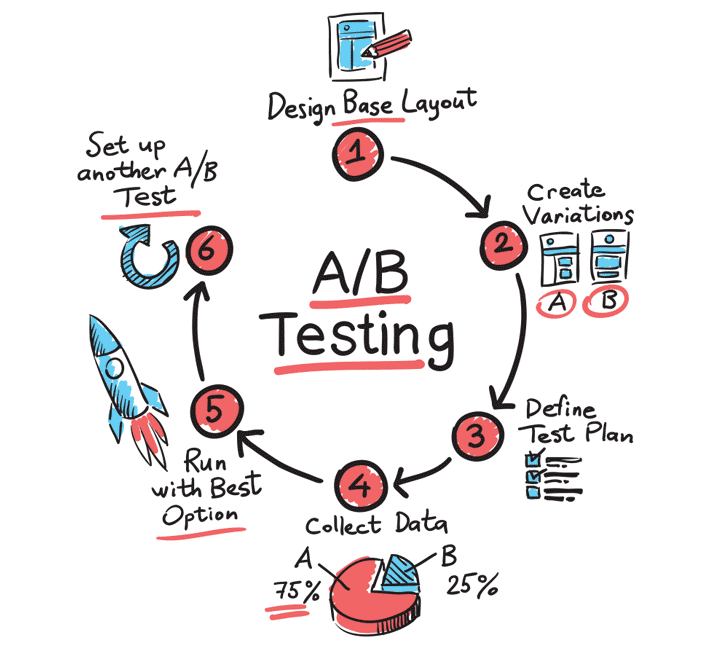
Here are some of the most common variables in an email experiment:
-
Subject line
-
From field
-
Email content
-
Send time
-
CTA
To run a split test, send half of your subscribers the original email and the other half the email with the changed variable.
If you were A/B testing different subject lines, for instance, your subscribers would receive identical emails except for the subject line. By comparing the two emails’ open rates, you can see which subject line performs better.
You could also try out two different CTAs to see which one leads to a higher click-to-open rate or test out different messaging in your email copy. The possibilities for A/B testing are nearly endless.
Some email marketing platforms, like ConvertKit, HubSpot, and ActiveCampaign, offer built-in functionality for split testing email content and subject lines.
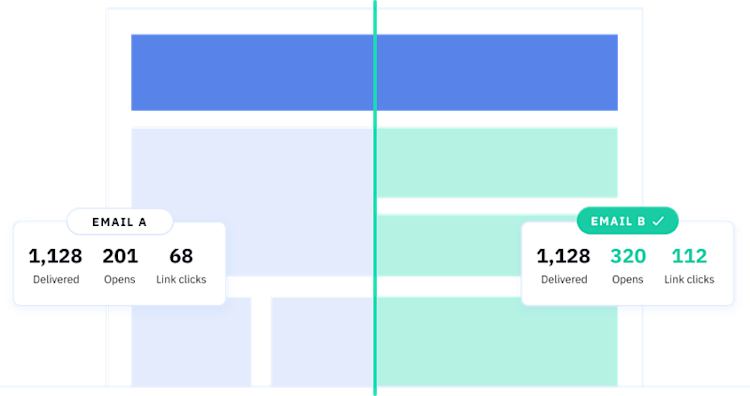
The more data you collect through A/B testing, the more you can optimize your current and future email campaigns to fit your audience’s needs and preferences. And the more your subscribers like your email content, the more likely they are to become customers.
Bottom line:
Don’t be afraid to experiment with your email campaigns to find what works best for you, your brand, and your audience. With the right metrics in mind and a little patience, you’ll be well on your way to converting more subscribers to customers.
5 simple steps to turn blog readers into happy customers
When you take away the marketing gimmicks, growth hacks, and buzzwords, converting blog readers into subscribers is simpler than it seems. It all comes down to these five steps:
-
Set goals for your email marketing strategy. What does success look like for your business?
-
Add an opt-in form or lead magnet to your blog. When you offer a valuable piece of content in exchange for your subscribers’ contact info, you make signing up a no-brainer.
-
Choose an email marketing platform. Podia is a top-tier choice for creators who want to manage their digital products and email marketing from one dashboard.
-
Send new subscribers a welcome email, then craft a lead nurture sequence that gets them excited to buy from you.
-
Don’t be afraid to experiment. Use A/B testing to discover what resonates with your audience, then update your campaigns accordingly.
With these five steps, you’re ready to turn blog subscribers into happy, nurtured customers. It may take some trial-and-error and a few experiments, but you’ve got this — and we can’t wait to watch you grow.
